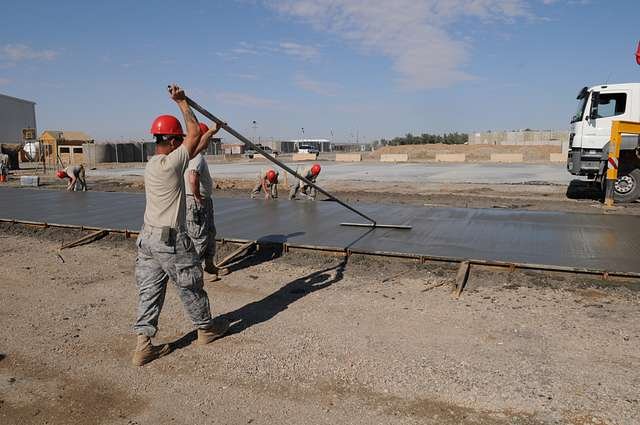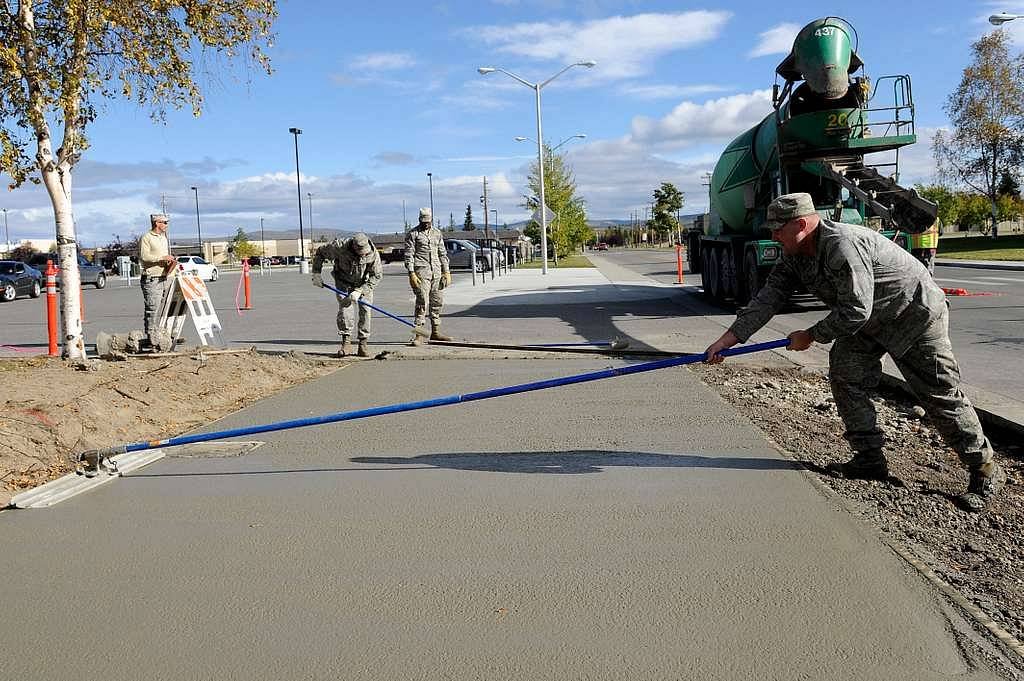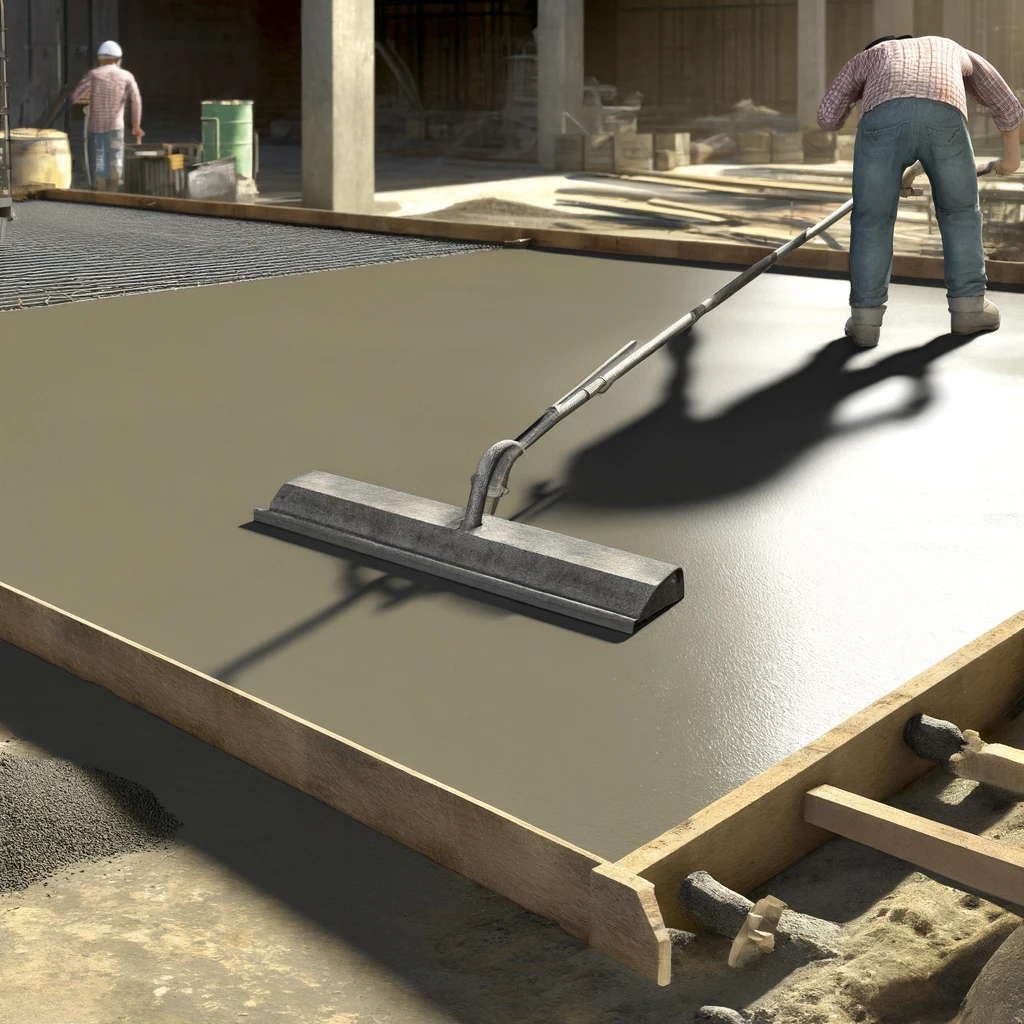Understanding Bull Float Concrete
Ever wonder what gives concrete its smooth and flat finish?
The secret lies in a process called ‘bull float.’
In straightforward terms, bull float refers to a wide-bladed tool used to smooth fresh concrete after it’s been placed. It’s not only about aesthetics, but it’s also crucial for the concrete’s structural integrity.
The bull float sweeps across the wet concrete’s surface, pushing the aggregate down and bringing finer materials to the top.
This practice results in a more leveled and durable surface, essential in every construction project.
Table of Contents
The Importance of Bull Floating in Concrete Construction

Purpose of Bull Floating
Bull floating serves a crucial purpose: to eliminate any highs and lows, bringing the aggregate, or small rocks used in the mix, down, and the cream, or water and cement, up.
This brings and keeps the moisture at the surface, enhancing the curing process and allowing for different finishing techniques to be applied.
Consequences of Neglecting to Bull Float
If you neglect the bull float process in your concrete construction, you risk encountering various potential pitfalls.
Uneven Concrete Surface
Without bull floating, the surface of the concrete may remain uneven, leading to potential tripping hazards and an overall unsatisfactory aesthetic look.
Poor Curing Process
The curing process may be compromised, as the necessary moisture may not be retained at the surface of the slab. This can lead to weaker concrete that may not stand up to time and the elements as well as it should.
Hard to Apply Finishes
Neglecting to bull float the surface makes it harder to apply other finishes. This could lead to the need for a total surface replacement, costing both time and money.
Rectifying the Effects of Neglecting to Bull Float
If you’ve already poured the concrete and didn’t bull float, don’t panic. You still have options for rectifying the situation. Depending on the degree of the problem, solutions may involve grinding down high spots, filling in low areas, or using a self-leveling compound. However, it’s recommended to seek professional assistance for such fixes.
Key Takeaways
- Bull floating is a critical process in concrete construction used to smooth and level the surface of freshly-poured concrete.
- Failure to bull float can lead to an uneven surface, a compromised curing process, and difficulties with later finishes.
- Rectification options are available, however, it’s better to get the process right from the beginning than trying to fix it later.
In conclusion, bull floating is not a step to be skipped in concrete construction. It’s an essential part of the process that ensures the concrete surface will be as durable, smooth, and aesthetically pleasing as it can be. When executed correctly, it can save you from unnecessary complications and costs in the long run.
Types of Bull Floats and their Effectiveness

Understanding Bull Float Varieties
The process and importance of bull floating in concrete construction remain consistent, regardless of the types of bull floats used. However, understanding the different kinds of bull floats can significantly boost the efficiency and effectiveness of the process. There are primarily three types of bull floats produced from different materials: aluminium, wood, and magnesium.
Aluminium Bull Floats
Aluminium bull floats are lightweight and highly durable, reducing the overall fatigue during the floating process. However, they are typically less effective in bringing the “cream”, or finer particles, to the surface, possibly affecting the smoothness and finish of the concrete slab.
Wood Bull Floats
Wooden bull floats are traditional, offering a controlled, gentle touch to the wet concrete surface. They excel in pulling up a rich amount of cream, which can enhance the final surface finish. Their weight, however, can be a downside, as they may require more effort to operate compared to lighter alternatives.
Magnesium Bull Floats
Utilising magnesium’s lightweight nature and incredible durability, these floats combine the benefits of both aluminium and wood models. They are preferred by many professionals for their balanced capabilities in smoothing the concrete surface and bringing up just the right amount of cream for an optimal finish.
Choosing the Right Bull Float

Size Matters
Beyond material, bull float sizes also play a significant role in the effectiveness of the job at hand. Larger bull floats provide a broader surface coverage, which can be beneficial for large projects or areas. On the other hand, smaller bull floats are relatively more maneuverable and can be ideal for smaller projects or tight spaces.
Handle Length Adjustment
The handle length of the bull float also matters when choosing the right tool. Ensure the handle can reach the farthest point without overstretching yourself for an efficient and safe operating process.
Shape and Design
Different float designs offer various advantages: a float with a rounded edge can prevent the creation of lines in the concrete, while a square end float can help reach corners more effectively.
| Type | Pros | Cons |
|---|---|---|
| Aluminium | Lightweight, Durable | Less effective in cream rising |
| Wood | Effective in cream rising, Gentle on surface | Heavier, More effort to operate |
| Magnesium | Lightweight, Durable, Balanced capabilities | Can be more expensive |
Choosing the right bull float can significantly impact the quality of the concrete surface and ease of constructability.
It boils down to understanding your project requirements and matching them to the correct bull float material, size, and design.
Each type comes with its pros and cons, but the ultimate decision aligns with achieving optimal results for your concrete construction.
Exploring Alternatives to Bull Floats in Concrete Construction

Considering Other Tools
If bull floating isn’t feasible, or if you’re working with an unusually large or small area of concrete, you might consider alternative tools.
Concrete Brooms
For an anti-slip finish, concrete brooms might be a valuable alternative. A broom finish is best on outdoor surfaces such as walkways and patios that may become slippery when wet. Still, they aren’t a complete replacement for a bull float as the broom leaves behind a distinct texture that may not be suitable for all applications. [source]
Power Trowels
If you’re dealing with a larger concrete area, a power trowel can be a viable alternative. Rather than manually floating the concrete, a power trowel uses a gasoline engine to run multiple trowel blades at high speeds across the surface of the concrete. However, this can be a costly solution due to high equipment and fuel costs. [source]
Hand Trowels
For smaller projects and tighter spaces, hand trowels are more manageable. They are smaller than bull floats, giving you greater control, but they require more labour intensity due to the smaller work area. Like the bull float, the hand trowel brings the cream to the surface, although using a hand trowel on larger projects could become tedious. [source]
Fresno Trowels
Another alternative is the Fresno trowel, a large hand tool dragged across the surface of the concrete. While the Fresno trowel does a fantastic job smoothing and compacting the surface, it doesn’t do as great of a job bringing the cream to the surface. Therefore, using a Fresno trowel often requires a follow-up pass with a bull float. [source]
Concrete Weight Factors
While bull floating or using an alternative method, remember to take into account the concrete’s weight. The type of aggregate and the amount used will affect the float process. With a heavier aggregate, you’ll have to work harder to smooth and level the surface. It’s crucial to select your tools appropriately considering these factors for efficient and effective concrete construction.
Conclusion On Bull Floating Concrete
There’s no one-size-fits-all solution in concrete construction. While the bull float is a trusted tool for levelling and smoothing concrete, there are several alternatives available that can fit into different project scopes, scales, and preferences.
Understanding the specifics of your concrete project, the tools at your disposal, and how they operate in different situations will ensure a well-executed concrete job.
Always remember to evaluate your options critically, as different tools bring different results, opportunities, and challenges. The goal should always be to achieve the best possible outcome for your project.
In conclusion, we’ve found that bull floating plays a pivotal role in concrete construction. Its function extends beyond merely leveling and smoothing the surface of the concrete; it maintains adequate moisture for the curing process and makes way for subsequent finishing methods. In our experience, skipping this crucial step can lead to undesirable results, such as uneven surface, poor quality of concrete, and difficulties with additional finishes.
From our perspective, even though rectification measures exist, it’s considerably more efficient and cost-effective to do it right from the outset. Hence, neglecting to bull float can lead to avoidable expenses, time loss, and lower quality workmanship. So, it’s in every concrete contractor’s best interest to ensure the process is precisely followed.
FAQ Section
1. What is a bull float?
A bull float is a wide-bladed tool used to smooth the surface of freshly poured concrete. It helps push down aggregate and bring finer materials to the top, resulting in a smooth and durable surface.
2. Why is bull floating important in concrete construction?
Bull floating is crucial for creating a smooth, level surface, enhancing the curing process, and making it easier to apply different finishing techniques. It also helps retain moisture at the surface, essential for proper curing.
3. What happens if I skip the bull floating process?
Neglecting to bull float can lead to an uneven surface, compromised curing, and difficulty applying finishes. This can result in weaker concrete, potential tripping hazards, and the need for costly surface replacements.
4. Can I fix concrete that wasn’t bull floated?
Yes, there are rectification options such as grinding down high spots, filling in low areas, or using a self-leveling compound. However, it’s recommended to seek professional assistance for such fixes.
5. What are the different types of bull floats?
Bull floats come in various materials, including aluminum, wood, and magnesium. Each type has its advantages and disadvantages:
- Aluminum: Lightweight and durable, but less effective in bringing the cream to the surface.
- Wood: Traditional, effective in pulling up the cream, but heavier and requires more effort to operate.
- Magnesium: Lightweight and durable, offering a balanced performance.
6. How do I choose the right bull float?
Choosing the right bull float depends on your project requirements. Consider the material, size, handle length, and design. Larger floats cover more area but are less maneuverable, while smaller floats are easier to handle in tight spaces. The handle should be long enough to reach the farthest point without overstretching.
7. Are there alternatives to bull floats?
Yes, alternatives include:
- Concrete brooms: For an anti-slip finish, suitable for outdoor surfaces.
- Power trowels: Ideal for large areas, using a gasoline engine to smooth the concrete.
- Hand trowels: Best for small projects or tight spaces, offering greater control but requiring more labor.
- Fresno trowels: A large hand tool that smooths the surface but may need a follow-up pass with a bull float.
8. How does the weight of concrete affect the floating process?
The type and amount of aggregate used in the concrete mix will affect the floating process. Heavier aggregates require more effort to smooth and level the surface. It’s important to select the right tools considering the concrete’s weight for efficient construction.
9. What are the key takeaways about bull floating?
- Bull floating is essential for a smooth, level concrete surface.
- Skipping this step can lead to uneven surfaces, poor curing, and difficulties with finishes.
- Rectification options exist, but it’s better to get the process right from the beginning.
10. Why is bull floating not a step to be skipped?
Bull floating ensures the concrete surface is smooth, durable, and aesthetically pleasing. Skipping this step can lead to avoidable expenses, time loss, and lower quality workmanship. It’s crucial for the concrete’s structural integrity and overall finish.






